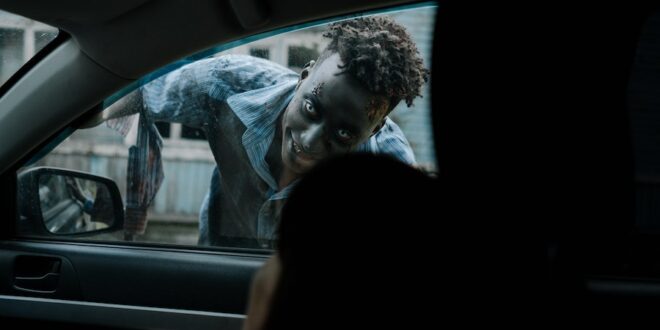One of the most bizarre movies in history raised questions to viewers, with many asking, “Was the human centipede real?”
The Human Centipede was a disgusting and terrifying movie that amerced a large following, almost like a cult that still loves it over a decade after its release.
But what is the real story behind the human centipede? Are the events depicted in the movie based on real-life events, or are they all the imaginations of a twisted writer?
This article will take a deep dive into the film to get you all these answers, so let’s get into it;
Was The Human Centipede Real?
The human centipede was inspired by horrific Nazi experiments shared by survivors of concentration camps, but it is not exactly as depicted in the movie.
Scientists and surgeons in Nazi Germany were performing inhumane and unethical experiments on victims in concentration camps.
Tom Six, the director, attributes the movie idea to a joke between his friends, the joke being how the best punishment for child molesters would be to be sewn to the anus of an overweight truck driver.
Metaphors and Theories About The Human Centipede
People knowing that True events inspired the Human Centipede contributed to its large following, but most people didn’t give it much thought. What were the directors using the movie to convey to their audience? Let’s find out;
The analogies that emerge from the graphics and offer further depth and nuance to the idea are at the core of The Human Centipede. The most evident are the parallels with Nazi Germany and actual stories from that era.
During the Nazi regime, several reports of German scientists attempted to conduct heinous experiments on humans.
Dr. Josef Mengele’s experimental endeavors were particularly noteworthy. These were actual stories about Human Centipede-like experiments.
These experiments added a grisly cap to an already repulsive period in history. Many experiments resulted in the unfortunate and reluctant participants suffering pain, impairment, trauma, and death.
Some tests were conducted on twins forcibly sewn together to simulate conjoined twins who suffer a similar fate.
Other experiments, including experimental bone, skin, muscle, and nerve transplants, were frequently performed without anesthetic.
Scientists would also experiment on unwitting victims with new biological weapons and medications.
New surgical treatments such as brain surgery and sterilization were also attempted with gusto, frequently with fatal results or, far worse, long-term medical consequences.
To emphasize the connection, the principal character, the scientist conducting these tests, is also appropriately named Dr. Josef Heiter. The Human Centipede is referring to these genuine accounts of heinous experiments.
What Made The Human Centipede Stand Out To Most Audiences?
The Human Centipede is no regular horror movie with a villain with a complicated goal and torturing people to get to it.
It took a much darker and twisted approach to its story and characterization that made the movie create a bigger splash in pop culture.
There’s no disputing that this contentious film left an impression. The Human Centipede did a fantastic job of grossing out spectators, but this picture left such a lasting impression because it taps into a terror that the horror genre isn’t used to.
Psychological terror is nothing unfamiliar, but the psychological fear exploited in The Human Centipede is. The Human Centipede delves into the “what if” scenario, establishing worse fates than death.
The story revolves around a successful conjoined twin surgeon who develops an unhealthy obsession with building the world’s first human centipede: stitching three individuals in a line, ass-to-mouth.
Lindsay, Jenny, and Katsuro are forced to participate in Dr. Josef Heiter’s macabre vision of sewing three individuals together by their gastrointestinal systems. Being linked to another individual for the rest of your life is terrifying.
There is little prospect of escape if you are the middle or end piece. Jenny is compelled to drink Katsuro’s poo because her mouth is tied to someone’s rear, as shown later in the feature. More crucially, all three characters are deprived of their liberty.
They can’t just return to their everyday lives of family, work, and fun; they’re stuck with a sick man without regard for their humanity. Lindsay, Jenny, and Katsuro are serving a life sentence in the confines of Dr. Heiter’s home.
They even lost the right to simply eat, sleep, and breathe as prisoners can do behind bars. With death, you are not subjected to physical and emotional torture daily by some maniac who regards you as a pet.
Characterization is an essential technique in storytelling for all genres of filmmaking, yet it is widely acknowledged that horror bends the rules a little when it comes to this style.
For example, Jaime Lee Curtis’ Laurie Strode is a cherished final girl, but her character lacks depth when appearing in the first Halloween film.
That storytelling method is prevalent in The Human Centipede since we know little about Lindsay, Jenny, and Katsuro. Still, their characters are well-crafted enough that they don’t appear unlikeable.
This works in the feature’s favor. If the backstories of these three protagonists had been revealed, viewers would have had a closer connection to Lindsay, Jenny, and Katsuro.
However, leaving an aura of mystery around them makes the incident more unpredictable. Though we are unaware of who they are, it’s easy to sympathize with them because Dr. Heiter has wicked intentions.
Their panic and fear quickly connect with viewers. The sensation of dread overrides our emotions with each passing second; the drama and tension stem from the psychological torment that these folks are subjected to.
They’re terrified because a twisted, insane man with a similarly unknown past has thrown off the status quo. When the human centipede is fully formed, the fear increases because it is now more difficult for these three to flee.
This could quickly have devolved into a gross-out creature in David Cronenberg’s The Fly or John Carpenter’s The Thing. Still, Tom Six skillfully avoids shattering the illusion of reality by not going beyond this strategy.
It’s why the first film in his three-part trilogy is still the finest, as Six chose the Texas Chainsaw Massacre path, focusing on the psychological aspect rather than the blood and gore.
The Dark Cinematic Choices Behind The Human Centipede
The Human Centipede was a revolutionary film that made waves in Hollywood, and it is still featured in many pop culture references an entire decade after its release.
This primarily owes to its dark and twisted approach to telling its story, which made it gory and timeless.
The Human Centipede, although lacking the subtlety of Wes Craven films or The Wicker Man, makes it evident that historical similarities are in the visual story that merits greater examination.
There is an implicit attempt to familiarize viewers with the certainty of situations that result in the loss of self-respect, comfort, and life.
The sense of approaching doom affects various victims differently, and their behaviors reveal fascinating details about who they are as people.
The lack of nuance and the deep dive into plain sensationalism bolsters this comparison significantly. Six practically dares the audience to turn away, and many do.
However, suppose you keep your eyes on the screen. In that case, you will notice the gradual but steady revelation of the human condition’s frailty and how it responds to an inevitable, unavoidable end.
The Human Centipede also serves as a nuanced reflection on modern misunderstanding, as naïve American tourists fall victim to this crazy scientist and are treated with a steely, persistent lack of empathy that seems to befit their vulgar, stupid natures.
Similarly, he deliberately positions the Japanese tourist at the head of his monstrous centipede. The only one of the three who can speak speaks only Japanese, a language he does not understand.
Katsuro’s final statement, in which he creates a moment of severe self-reflection and compares the doctor to God, brings the metaphor to a close.
Despite its horrifying sights, The Human Centipede remained a vital cog in the wheel of horror cinema because of a committed audience that accepted the metaphors it depicts.
There were also confirmed true stories of experimentation, which The Human Centipede draws on. This enabled it to climb beyond ignominy and sustain a cult following for decades.
Director Tom Six also deviated from the template to create two completely different sequels, each with its style of metaphor, narration, and even more stark, disgusting imagery to emphasize the point.
Conclusion
For those wondering, was The Human Centipede real? You now have a better understanding of the inspiration and source of the movie. The movie was based on recollections of World War II Nazi camp survivors subjected to inhumane experiments in concentration camps.
The experiments were not precisely similar to what is depicted in The Human Centipede, but there are many similarities.
It paints a clear picture of the dark side of humans and experimental science while terrifying and grossing out viewers. It is a true masterpiece of horror cinema.
 Being Human
Being Human



